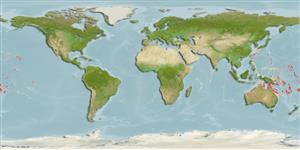>
Ovalentaria/misc (Various families in series Ovalentaria) >
Pomacentridae (Damselfishes) > Pomacentrinae
Etymology: Amphiprion: Greek, amphi = on both sides + Greek, prion, -onos = saw (Ref. 45335); pacificus: Named for its Pacific Ocean distribution.
Environment: milieu / climate zone / depth range / distribution range
Écologie
marin récifal; profondeur 4 - 10 m (Ref. 85065). Tropical
Pacific: Wallis Island, Tonga, Fiji and American Samoa.
Taille / Poids / Âge
Maturity: Lm ? range ? - ? cm
Max length : 4.8 cm SL mâle / non sexé; (Ref. 85065)
Description synthétique
Clés d'identification | Morphologie | Morphométrie
Épines dorsales (Total) : 9; Rayons mous dorsaux (Total) : 18 - 20; Épines anales: 2; Rayons mous anaux: 12 - 13. This species is distinguished by the following set of characters: D IX,18-20; A II,12-13; pectoral rays 17-18; tubed lateral line scales 33-48; gill rakers 5-6 + 11-12; opercular spinules 8-11; body depth 2.2-2.6 in SL; color generally pinkish brown, usually grading to yellowish or orange on lower side of body including abdomen; white stripe on midline of snout extending posteriorly on forehead and along base of dorsal fin; fins whitish to semi-translucent (Ref. 85605).
This species is generally commensal with the anemone Heteractis magnificus (Quoy & Gaimard, 1833) at depths between about 4-10 m (Ref. 85065). Oviparous, distinct pairing during breeding (Ref. 205). Eggs are demersal and adhere to the substrate (Ref. 205). Males guard and aerate the eggs (Ref. 205).
Life cycle and mating behavior
Maturité | Reproduction | Frai | Œufs | Fécondité | Larves
Oviparous, distinct pairing during breeding (Ref. 205). Eggs are demersal and adhere to the substrate (Ref. 205). Males guard and aerate the eggs (Ref. 205).
Allen, G.R., J. Drew and D. Fenner, 2010. Amphiprion pacificus, a new species of anemonefish (Pomacentridae) from Fiji, Tonga, Samoa, and Wallis Island. aqua, Int. J. Ichthyol. 16(3):129-138. (Ref. 85065)
Statut dans la liste rouge de l'IUCN (Ref. 130435: Version 2024-1)
Menace pour l'homme
Harmless
Utilisations par l'homme
Outils
Articles particuliers
Télécharger en XML
Sources Internet
Estimates based on models
Preferred temperature (Ref.
123201): 25.2 - 29.4, mean 27.6 °C (based on 704 cells).
Phylogenetic diversity index (Ref.
82804): PD
50 = 0.5000 [Uniqueness, from 0.5 = low to 2.0 = high].
Bayesian length-weight: a=0.01479 (0.00651 - 0.03363), b=3.00 (2.81 - 3.19), in cm total length, based on LWR estimates for this (Sub)family-body shape (Ref.
93245).
Niveau trophique (Ref.
69278): 2.8 ±0.3 se; based on size and trophs of closest relatives
Résilience (Ref.
120179): Haut, temps minimum de doublement de population inférieur à 15 mois (Preliminary K or Fecundity.).
Fishing Vulnerability (Ref.
59153): Low vulnerability (10 of 100).
